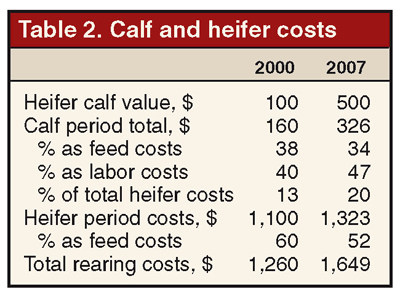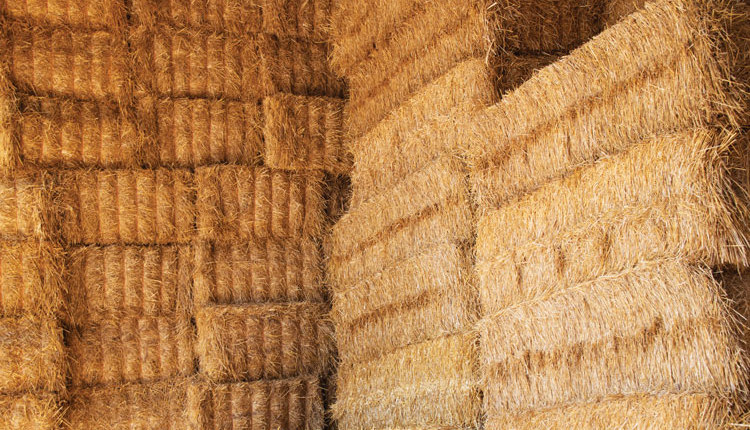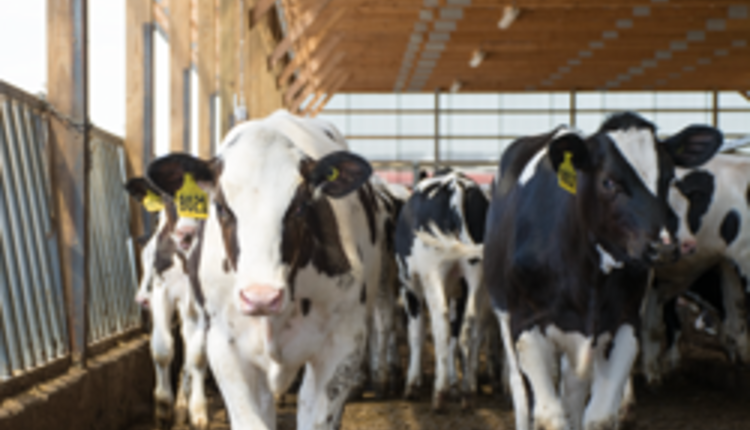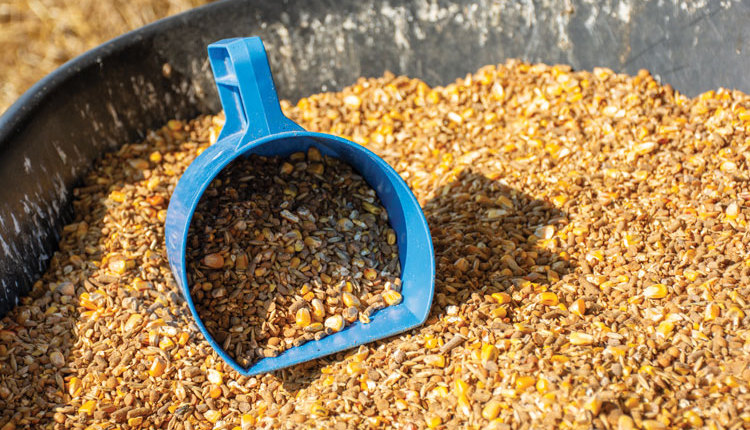How calves did in a Cornell study which evaluated starters with two levels of fiber and in pelleted or mash (texturized) forms was covered in a previous column in the May 10, 2007, issue, page 340. Calves were in individual crates, so there was no bedding consumption to confound the results.
There were some benefits of the high-fiber versus low-fiber calf starter. That is to be expected with lower starch content when starters are formulated for higher fiber. And there would be fewer tendencies for marginal ruminal acidosis with higher-fiber starters. But the main advantages in this study were for the mash starter versus pelleted starter. (See Table 1.)

• Improved daily gain postweaning (5 to 8 weeks) and overall, as well
• Greater starter intake after weaning and overall, as well
• Earlier ruminating
• More time spent ruminating
All of these differences were statistically significant. In addition, calves sacrificed on each treatment had numerically improved rumen pH, papillae length, and percent muscle/mucosa. All indicate rumen function and development consistent with the performance parameters.
What about forage?
Now, what if straw or roughage is fed? Recently, at a large herd calf operation, I observed only one calf ruminating. Calves were housed in straw-bedded hutches and fed a pelleted calf starter. I do not know of any study that has measured straw intake when calves are bedded on straw.
What would the straw do in the rumen? We know it does not ferment much, produces the wrong balance of volatile fatty acids for rumen papillae development, and contributes to rumen fill which distorts and confounds true body weight gain and feed efficiencies.
Hay would have similar effects when fed to calves under 2 months of age. When the benefits of texturized starters are seen as in this study, the rejoinder usually is "but texturized starters cost more!" That brings up a second issue . . . costs.
A study in 2000 summarized and reported calf and heifer costs (Figure 1) on 62 dairies in Wisconsin. (April 25, 2000, issue, page 303.) Note that, while daily costs were the greatest for the two-month calf period, the largest component of that cost was 40 percent for labor followed by 38 percent for feed. Daily feed costs actually were greater for older heifers as maintenance cost increases with body weight. Even though lower cost per- pound or per-ton feeds can be used with larger heifers, the efficiency of nutrient conversion to growth is lower due to greater body maintenance costs then. In fact, in some cases, cost per pound of gain can even be the lowest during the calf period because of this greater efficiency of nutrient conversion to gain at lower body weight.
Calf accounts for little . . .
Furthermore, of the total costs to raise a heifer in that Wisconsin study eight years ago, only $160, or 13 percent of the $1,260 to raise a heifer, came in the first two-month calf period. In 2000, a heifer calf was valued at $100 which would need to be added to the $1,260 heifer-raising costs to get a total cost of the heifer. Of the total heifer period rearing costs, 60 percent was feed costs, reflecting greater maintenance cost with larger size.
This study essentially was repeated in 2007 using 49 dairy operations. It was reported in a series, "Real Herds, Real Heifers" in the January 10 through March 25 issues in 2008. (Or see: http://www.wisc.edu/dysci/uwex/heifmgmt/heiferreport.html) Some of the cost differences from the 2000 report are: A heifer calf was worth $500 in 2007 rather than $100, labor cost rose from $7 to $12 an hour, and management cost went from $12 to $20 an hour. Results in Figure 2 illustrate a similar pattern to 2000 but with some notable differences. (See Table 2.)

From 2000 to 2007, calf value went up five-fold while total calf period costs were "only" doubled. The latter primarily was a function of higher labor costs which accounted for nearly one-half of the daily calf costs. Calf period costs grew from 13 to 20 percent of total heifer rearing costs.
A word of caution . . .
Here is the concern. There often is undue focus on cutting calf feed costs. If you chose a lower quality milk replacer, lower feeding level, or lower cost calf starter, you might save $25 to $50 per calf. That would be only 15 percent at the maximum of the daily calf costs and only 2 to 3 percent of total heifer-rearing costs you incur.
Poorer nutrition then would be provided to the most vulnerable and responsive animals on your dairy where the efficiency and return opportunity is the greatest. The best approach to cut calf period costs would be to reduce weaning age from an average of 8 to 6 weeks. This would reduce both the cost of the liquid feeding program and labor - the largest cost components of caring for and raising calves - but not reduce calf performance. And the calf then would be in a better situation for moving into a group and ration change after 2 months of age. With good milk replacer and calf starter feeding programs, that is a very realistic approach.
Last, there is newer data that improved daily gain of the calf without fattening before weaning is associated with higher first-lactation milk yield. There are indications that, even at this young calf age, critical mammary gland development is taking place. So we need to reevaluate goals and objectives of our calf starter and liquid feeding programs. Our objectives should be to maximize performance of calves, and their subsequent milk yields, rather than look to simply cut costs of calf feeding programs.

Click here to return to the Calf & Heifer E-Sources
090325_224
There were some benefits of the high-fiber versus low-fiber calf starter. That is to be expected with lower starch content when starters are formulated for higher fiber. And there would be fewer tendencies for marginal ruminal acidosis with higher-fiber starters. But the main advantages in this study were for the mash starter versus pelleted starter. (See Table 1.)

• Improved daily gain postweaning (5 to 8 weeks) and overall, as well
• Greater starter intake after weaning and overall, as well
• Earlier ruminating
• More time spent ruminating
All of these differences were statistically significant. In addition, calves sacrificed on each treatment had numerically improved rumen pH, papillae length, and percent muscle/mucosa. All indicate rumen function and development consistent with the performance parameters.
What about forage?
Now, what if straw or roughage is fed? Recently, at a large herd calf operation, I observed only one calf ruminating. Calves were housed in straw-bedded hutches and fed a pelleted calf starter. I do not know of any study that has measured straw intake when calves are bedded on straw.
What would the straw do in the rumen? We know it does not ferment much, produces the wrong balance of volatile fatty acids for rumen papillae development, and contributes to rumen fill which distorts and confounds true body weight gain and feed efficiencies.
Hay would have similar effects when fed to calves under 2 months of age. When the benefits of texturized starters are seen as in this study, the rejoinder usually is "but texturized starters cost more!" That brings up a second issue . . . costs.
A study in 2000 summarized and reported calf and heifer costs (Figure 1) on 62 dairies in Wisconsin. (April 25, 2000, issue, page 303.) Note that, while daily costs were the greatest for the two-month calf period, the largest component of that cost was 40 percent for labor followed by 38 percent for feed. Daily feed costs actually were greater for older heifers as maintenance cost increases with body weight. Even though lower cost per- pound or per-ton feeds can be used with larger heifers, the efficiency of nutrient conversion to growth is lower due to greater body maintenance costs then. In fact, in some cases, cost per pound of gain can even be the lowest during the calf period because of this greater efficiency of nutrient conversion to gain at lower body weight.
Calf accounts for little . . .
Furthermore, of the total costs to raise a heifer in that Wisconsin study eight years ago, only $160, or 13 percent of the $1,260 to raise a heifer, came in the first two-month calf period. In 2000, a heifer calf was valued at $100 which would need to be added to the $1,260 heifer-raising costs to get a total cost of the heifer. Of the total heifer period rearing costs, 60 percent was feed costs, reflecting greater maintenance cost with larger size.
This study essentially was repeated in 2007 using 49 dairy operations. It was reported in a series, "Real Herds, Real Heifers" in the January 10 through March 25 issues in 2008. (Or see: http://www.wisc.edu/dysci/uwex/heifmgmt/heiferreport.html) Some of the cost differences from the 2000 report are: A heifer calf was worth $500 in 2007 rather than $100, labor cost rose from $7 to $12 an hour, and management cost went from $12 to $20 an hour. Results in Figure 2 illustrate a similar pattern to 2000 but with some notable differences. (See Table 2.)

From 2000 to 2007, calf value went up five-fold while total calf period costs were "only" doubled. The latter primarily was a function of higher labor costs which accounted for nearly one-half of the daily calf costs. Calf period costs grew from 13 to 20 percent of total heifer rearing costs.
A word of caution . . .
Here is the concern. There often is undue focus on cutting calf feed costs. If you chose a lower quality milk replacer, lower feeding level, or lower cost calf starter, you might save $25 to $50 per calf. That would be only 15 percent at the maximum of the daily calf costs and only 2 to 3 percent of total heifer-rearing costs you incur.
Poorer nutrition then would be provided to the most vulnerable and responsive animals on your dairy where the efficiency and return opportunity is the greatest. The best approach to cut calf period costs would be to reduce weaning age from an average of 8 to 6 weeks. This would reduce both the cost of the liquid feeding program and labor - the largest cost components of caring for and raising calves - but not reduce calf performance. And the calf then would be in a better situation for moving into a group and ration change after 2 months of age. With good milk replacer and calf starter feeding programs, that is a very realistic approach.
Last, there is newer data that improved daily gain of the calf without fattening before weaning is associated with higher first-lactation milk yield. There are indications that, even at this young calf age, critical mammary gland development is taking place. So we need to reevaluate goals and objectives of our calf starter and liquid feeding programs. Our objectives should be to maximize performance of calves, and their subsequent milk yields, rather than look to simply cut costs of calf feeding programs.

090325_224










